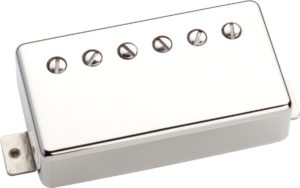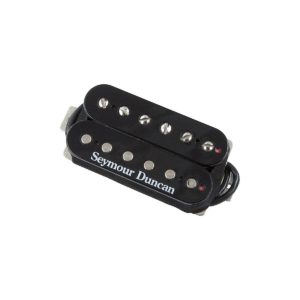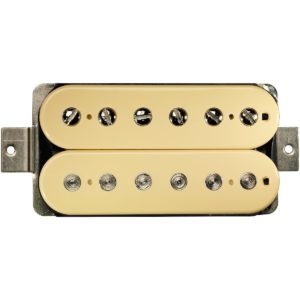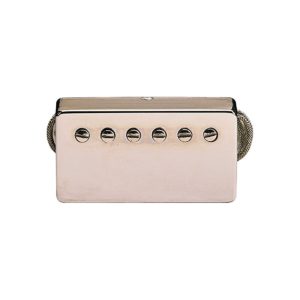Are you looking for the best jazz guitar pickups? Then, you’re in the right place.

Jazz guitarists are among the most influential in all music, and behind each great player, there is an excellent piece of kit made of significant components.
However, how do you select these? What effect do they have? Finally, and most importantly, how do you choose the correct kit for the job as a buyer?
Many components make up a guitar, but in this guide, we will discuss the best jazz guitar pickups, which pick up the strings’ vibration and convert them into electrical signals for output.
Best Jazz Guitar Pickups – Comparison Table
1. Seymour Duncan SH-1N 1959 Model (Editor’s Choice)
This pickup was also designed with the original PAF 50’s humbuckers in mind, meaning and the ’57 Classic and Classic Plus.
It delivers warm, round-bottomed low end, with slightly boosted glassy highs and slightly scooped mid-frequencies for a versatile, true-to-vintage sound that provides character to whichever guitar it is matched with.
The consensus is that the SH-IN ’59 is glassier in the high frequencies than most humbuckers while remaining full and smooth in the mid and low frequencies.
It’s known to have a smooth clarity that allows single notes in chords to ring out exceptionally well and is capable of being very crisp and clean as well as bold.
It has a versatile output level and feeds tube amps well, providing a signal suitable for distortion and saturation. Its accuracy in the higher frequencies may lend itself best to jazz playing, which involves many runs or other intricacies.
By all accounts, the SH-IN ’59 Model is exceptionally versatile. Its application for jazz music covers all the bases, from edgier riffs with more chord action to intricate runs and soloing.
It ensures full coverage that allows your tone to be well articulated, smooth, and slick.
Pros
- The most versatile pickup in the line-up
- It lacks quite the same warmth as the ’57 Classic.
- Allows intricate playing to shine
Cons
- No real cons, but it may lack a specific quirkiness due to its well-roundedness!
2. Gibson Classic Plus ’57 Humbucker
Along with the Classic ’57, these are some of Gibson’s high-end humbuckers. Perhaps these are the pickups most associated with Gibson’s vintage sound.
They are shipped with Les Pauls and are faithful reproductions of the originals used by guitarists such as Eric Clapton on his Bluesbreakers ’66 album with John Mayall, B.B King, and the Allman Brothers.
The Plus is the same as the ’57 Classic, with extra wire turns in the coil, increasing its output without sacrificing tone.
That is true to the original PAF pickups of the late ’50s, which accidentally received a few more coils in manufacturing. Unfortunately, the tone brought about by this mistake has stuck to this day!
Therefore, the ’57 Plus reacts better in its velvety warm production of low-frequencies while providing more edge for a bridge pickup.
The ’57 Plus can be described as having a juicy low and mid-end with a smooth, velvety high-end, perhaps lending itself to darker, louder tones.
The Classic ’57 and ’57 Plus has remained the choice of many jazz and blues players and is frequently seen as an after-market upgrade to guitars other than Gibson’s.
A standard setup is to have the ’57 Plus on the bridge and a ’57 classic on the neck, as the ’57 Plus provides thicker, smoother harmonics best suited to the bridge.
If you need a pickup to handle more gain, overdrive, and distortion while remaining smooth and rounded, then ’57 does an exceptional job.
Pros
- Higher output than most jazz pickups
- The darker, smoother, and warmer tone
- Detail preserved in the high frequencies
- Perfect for more distorted or more saturated tones
Cons
- Some mid-frequency cut traded for more body in the mid and low frequencies
- May not be muted and neutral enough for some jazz tones; it could almost have too much character for some players
3. Seymour Duncan SH2N Jazz Model
This humbucker pickup is considered more versatile than its name suggests and is the pickup of choice for many metal players, like Dave Mustaine from Megadeth and rock legend Jeff Beck.
Like in jazz, there is a need for accurate reproduction of speedy, precise runs of notes that need to slot into the mix.
The SH Jazz articulation is due to its scooped mid-frequencies, providing glassy brightness that shimmers with character. In addition, it remains well-rounded in the low frequencies, giving it the body you need for jazz.
It is a reasonably low output pickup but can still be driven to louder volumes while remaining clear and smooth.
Clearness, punch, brightness, and shimmer are all words associated with this pickup’s tone, and it is frequently used as an after-market upgrade in many guitars, including Les Pauls and Jackson RRs.
When people play using this pickup, they’re usually taken back by its crispness and delighted by its lovely handling of drive and saturation, particularly when coupled with tube amps, to provide a genuinely vintage yet flexible tone.
Pros
- Perhaps the most faithful of the line-up to a real, neutral, but characterful jazz tone that lets the playing do the talking
- Versatile in that it accurately produces high frequencies for a high-end sheen, which is a valuable quality to many genres
Cons
- Low output favors high-end, so may lack some boldness in the lower frequencies
- May be quieter, and more muted, lending itself less to distorted tones than other listed pickups
4. DiMarzio PAF 36th Anniversary
The free and open-breathing DiMarzio PAF 36th Anniversary pickup is a great vintage pickup with exceptional character.
It is tightly wound, giving it a controlled essence to what is otherwise a decidedly thick, warm tone, with plenty of high-end clarity and cut.
Its inspiration came from the original PAF 50’s pickups. Thus it has the essence of a single-coil pickup without unwanted hiss or noise, providing a clear, rich tone with considerable depth.
The magnetic field is relatively weak in the DiMarzio PAF, allowing smoothness to translate from any guitar, providing the focus and attack reminiscent of old records.
It reportedly functions very well in pinch harmonics, which pierce heavier mixes and quieter ones and provide a shimmer to solos across many genres.
It offers depth, warmth, detail, and glassy high-end for jazz, translating into intricate playing very well at low and high volumes, clean or distorted.
It’s suitably dark, meaning it’s perfect for moody playing, evoking that 50’s warmth without compromising modern applications in high-gained, effects-driven settings.
Pros
- A healthy balance between clarity in the highs and charisma in the lows
- Plenty of shimmery attack for accurate representation of complex playing
Cons
- Mid-frequency tones are less thick due to their bias towards the more clear high-frequencies
- Too much color for some players may seem too low-fi and characterful
Buyer’s Guide: How to Shop for the Best Jazz Guitar Pickups
How Do Pickups Affect The Sound Of A Guitar? How Do They Work?
Many factors add up to form the tone of a guitar. The materials and assembly of the instrument, your strings, the amp, cables, and of course, your style.
Pickups are at the heart of this, providing the link between the guitar’s physical vibration and its strings and the sound output to your speakers and amps.
When we find ourselves jealous of another guitarist’s tone, we should check the pickups they are using.
These pickups greatly influence subtle harmonics, providing a more vintage sound, perhaps a more metallic one, or a crystal clear, smooth tone with little distortion.
Pickups comprise wire coils wrapped around magnets, forming a magnetic field. When this field is disturbed by string vibration, it creates a small, meaningful voltage output for amplification.
The Main Types Of Pickups
Single Coil Pickups
Think Fender Stratocaster or Telecaster, and that edgy, metallic twang, which provides a satisfying snap.
Single coil pickups sound great with clean amp settings and are sure to cut through the mix, they tend to hum more than other pickups, and some players love that as it provides that authentic vintage sound.
P90 Single Coil Pickups
Think vintage Gibson and that fuller, wider-ranged sound that is both twangy and snappy but also well-rounded and warm. P90s gain this character by having a wider coil with wider frequency response.
Humbuckers
Humbucker means to buck the hum by using two coils, which stops the hum created by single-coil pickups.
Humbuckers may perform more reliably if you amplify your guitar to a high volume with lots of gains and drive. They sound less ‘edgy’ than their single-coil counterparts and provide a more rounded sound.
What Tone Do You Need To Play Jazz?
When we talk about jazz guitar tone, we mainly talk about the greats’ characteristic warmth on old 60’s records.
This ubiquitous dark, warm, and fat tone let the woodier tones of the guitar breathe. We have the cleaner ‘hollow’ sound that displays more of a metallic twang.
Take John Schofields ‘A GO GO’, the guitar has a subtle warmth with a definite edge, but it’s also deafening. Instead, John uses a Super 58 humbucker pickup that gives him the license to riff out with his band behind him while providing an outstanding balance in sections where the dynamics are quieter.
Kenny Burrell uses P90s and other single-coil pickups in his self-titled album on Blue Note records to get that sharp hollow twang with vintage flavor.
The Best Pickup for Jazz Guitar: Final Thoughts
The four pickups described are no doubt amongst the best jazz pickups.
Between them, we have access to tones ranging from more resonant, darker, more moody sounds reminiscent of the rougher bluesy side of jazz to the glassy, high-end twang that allows your guitar voice to translate to an audience.
The best comes down to where you fall in this spectrum. If you want a sound that’s fat and smooth, the Gibson ’57s are sure to provide that characteristic warmth.
For a glassy, high-end tone that displays your solos in the best light, the DiMarzio PAF’s may tick the boxes, or perhaps the Seymour Duncan Jazz Model can provide that neutral yet characterful tone.
The Seymour Duncan SH ’59 provides a versatile vintage tone for a wide range of guitars, but does it lack that slight quirk?
Overall, the best jazz guitar pickup may well depend on whether you’ve decided upon your niche or personal favorite tone.


